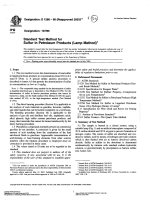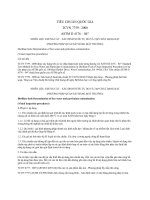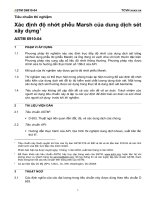Astm d 603 66 (1996)e1
Bạn đang xem bản rút gọn của tài liệu. Xem và tải ngay bản đầy đủ của tài liệu tại đây (33.51 KB, 2 trang )
Designation: D 603 – 66 (Reapproved 1996)e1
AMERICAN SOCIETY FOR TESTING AND MATERIALS
100 Barr Harbor Dr., West Conshohocken, PA 19428
Reprinted from the Annual Book of ASTM Standards. Copyright ASTM
Standard Specification for
Aluminum Silicate Pigments (Hydrous)1
This standard is issued under the fixed designation D 603; the number immediately following the designation indicates the year of
original adoption or, in the case of revision, the year of last revision. A number in parentheses indicates the year of last reapproval. A
superscript epsilon (e) indicates an editorial change since the last revision or reapproval.
e1 NOTE—Keywords were added editorially in May 1996.
TABLE 1 Pigment Composition Requirements
1. Scope
1.1 This specification covers the white pigments that consist
substantially of natural hydrous aluminum silicate2 (of the 1:1
layer type), and are restricted to those minerals which conform
to the chemical limits prescribed herein and which can be
suitably processed to what is commercially known as paint
pigment quality.
Aluminum oxide, Al2O3, %
Silicon dioxide, SiO2, %
Iron oxide, Fe2O3, %
Titanium dioxide, TiO2, %
Calcium oxide, CaO,%
Sodium oxide, Na2O, %
Potassium oxide, K2O, %
Other oxides, %
Free moisture (105°C), %
Loss on ignition
(1000°C), %
2. Referenced Documents
2.1 ASTM Standards:
D 281 Test Method for Oil Absorption of Pigments by
Spatula Rub-Out3
D 422 Test Method for Particle-Size Analysis of Soils4
D 718 Test Methods for Analysis of Aluminum Silicate
Pigment5
D 1208 Test Methods for Common Properties of Certain
Pigments5
D 1483 Test Method for Oil Absorption of Pigments by
Gardner-Coleman Method3
D 2448 Test Method for Water-Soluble Salts in Pigments by
Measuring the Specific Resistance of the Leachate of the
Pigment5
E 70 Test Method for pH of Aqueous Solution with the
Glass Electrode6
A
B
Ideal
Typical
Range
Max
39.50
46.54
...
...
...
...
...
...
...
13.96
38.8
45.4
0.3
1.5
0.1
0.1
0.1
trace
...
13.8
37 to 42A
48 to 43B
...
...
...
...
...
...
...
...
...
...
0.5
2.0
0.2
0.3
2.0
0.1
1.0
15.0
Permitting up to 5 % excess Al2O3, for example as allophane.
Permitting up to 5 % excess SiO2, for example as quartz.
3.3 Water-Soluble Matter—The water-soluble matter shall
be not more than 0.50 %.
3.4 Wet-Sieve Residue—The pigment shall contain no more
than 0.5 % wet-sieve residue retained on a 45-µm (No. 325)
sieve (“grit” or “coarse particles”) except as may be agreed
upon between the purchaser and the seller.
3.5 Color—The color (brightness, reflectance) shall conform to the following requirements:
3.5.1 The color shall be equal, within agreed upon tolerances, to that of a reference standard agreed upon between the
purchaser and the seller, or
3.5.2 The color shall be not less than a guaranteed minimum
expressed as percent reflectance of standard illuminant C at
457 nm compared to a freshly smoked standard magnesium
oxide surface by means of an accepted integrating sphere
reflectance spectrophotometer7 or a monochromatic reflectance
meter,7 or
3.5.3 The color shall be specified by actual determination of
dominant wavelength, hue, and spectral efficiency as can be
calculated from the tristimulus integration of the reflectance
curve.
3.6 Oil Absorption—The oil absorption shall be equal,
within agreed upon tolerances, to that of a reference standard
agreed upon between the purchaser and the seller.
3.7 Aluminum silicate pigments may be furnished in several
types or grades whose various properties are dependent in part
3. Composition of Properties
3.1 Preparation—The pigment shall be made by grinding,
milling, washing, purifying, size-fractionating, or otherwise
processing, natural hydrous aluminum silicates, and shall
conform to the composition requirements (weight percent)
given in Table 1.
3.2 pH—The pH of a water slurry of the pigment shall be
within a range as agreed upon between the purchaser and the
seller.
1
This specification is under the jurisdiction of ASTM Committee D-1 on Paint
and Related Coatings, Materials, and Applications, and is the direct responsibility of
Subcommittee D01.31 on Pigment Specifications.
Current edition approved Sept. 20, 1966. Originally issued 1941. Replaces
D 603 – 42 (1955).
2
Synonymous terms are china clay and kaolinite.
3
Annual Book of ASTM Standards, Vol 06.01.
4
Annual Book of ASTM Standards, Vol 04.08.
5
Annual Book of ASTM Standards, Vol 06.03.
6
Annual Book of ASTM Standards, Vol 15.05.
7
The General Electric Reflectance Spectrophotometer and the General Electric
Reflectance Meter, respectively, have been found satisfactory for this purpose.
1
D 603
on average size or particle size distribution about the average,
or both. The particle size shall be equal within agreed upon
tolerances to that of a reference standard agreed upon between
the purchaser and the seller.
not covered by ASTM test methods shall be agreed upon
between the purchaser and the seller, except as follows:
5.1.1 Hydrogen Ion Concentration (pH)—Prepare a sample
having 20 % solids, but otherwise in accordance with Test
Methods D 1208. Determine the pH in accordance with Test
Method E 70 except to maintain sufficient agitation of the
slurry such that all particles are in suspension at time of
measurement.
5.1.2 Water-Soluble Matter—Test Method D 2448.
5.1.3 Coarse Particles—Test Methods D 718.
5.1.4 Oil Absorption—Test Method D 281 or D 1483.
5.1.5 Particle Size Distribution—Method D 422.
5.1.6 Chemical Analysis—Test Method D 718.
4. Number of Tests
4.1 Two samples shall be taken at random from different
packages from each lot, batch, day’s pack, or other unit of
production in a shipment. When no markings distinguishing
between units of production appear, samples shall be taken
from different packages in the ratio of two samples for each
10 000 lb (4540 kg), except that for shipments of less than
10 000 lb two samples shall be taken. At the option of the
purchaser, the samples may be tested separately or after
blending in equal quantities the samples from the same
production unit to form a composite sample.
6. Keywords
5. Test Methods
5.1 Tests shall be conducted in accordance with the appropriate ASTM test methods, where applicable. Test procedures
6.1 aluminum silicate (hydrous); clay; pigments
The American Society for Testing and Materials takes no position respecting the validity of any patent rights asserted in connection
with any item mentioned in this standard. Users of this standard are expressly advised that determination of the validity of any such
patent rights, and the risk of infringement of such rights, are entirely their own responsibility.
This standard is subject to revision at any time by the responsible technical committee and must be reviewed every five years and
if not revised, either reapproved or withdrawn. Your comments are invited either for revision of this standard or for additional standards
and should be addressed to ASTM Headquarters. Your comments will receive careful consideration at a meeting of the responsible
technical committee, which you may attend. If you feel that your comments have not received a fair hearing you should make your
views known to the ASTM Committee on Standards, 100 Barr Harbor Drive, West Conshohocken, PA 19428.
2









